
The 2008 Global Financial Crisis (GFC) brought about an extraordinary fiscal and monetary response from the world’s governments.
Nowhere was this response as grand as in China, which rolled out an enormous stimulus package worth some four trillion yuan ($US570 billion), mostly in the form of fixed asset investment, including the construction of roads, railways, and buildings.
To say that China’s stimulus package was a ‘success‘ is an understatement. As the Western economies entered recession in 2009, the contraction of Chinese exports – which lopped around 3% off China’s GDP – was more than offset by an increase in fixed asset investment, which peaked at a whopping 90% of GDP in 2009 (see the below chart).
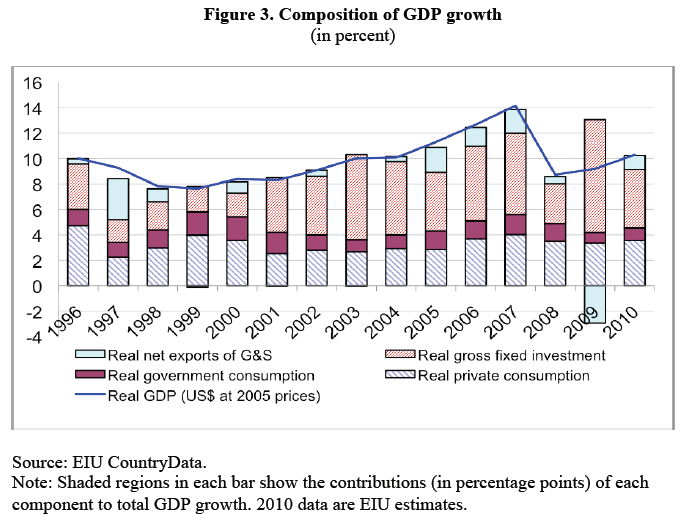
A key ingredient of China’s fixed asset investment is steel, which is used in the construction of buildings, structures and machinery, with the construction industry accounting for more than half of China’s steel consumption.
Earlier this month, Tom Conley presented some fascinating RBA charts on China’s steel production, which has expanded rapidly, growing at an average annual rate of 7% during the 1980s, 10% during the 1990s and around 20% in the 2000s:
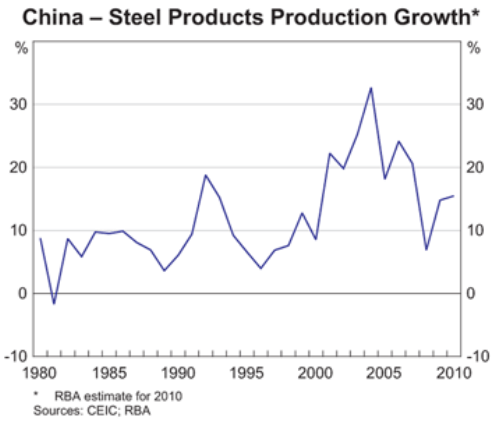
Following this strong growth, China now accounts for around 45% of global steel production, compared with around 15% at the start of the 2000s:
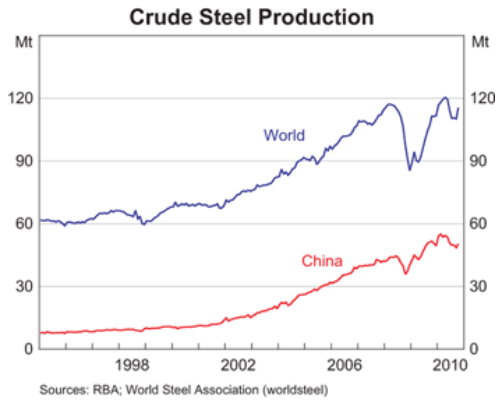
And with this growth of steel production, the Chinese have become increasingly reliant on imported iron ore and coking coal:
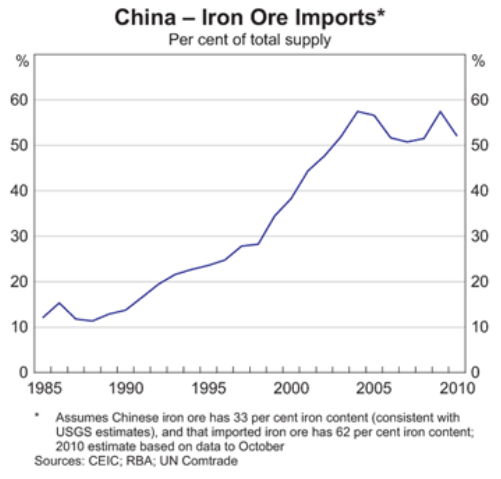
Australia, which is a major exporter of both iron ore and coking coal, has obviously benefited immensely from the increased demand from China, as evident by the surge of contract prices since 2005:
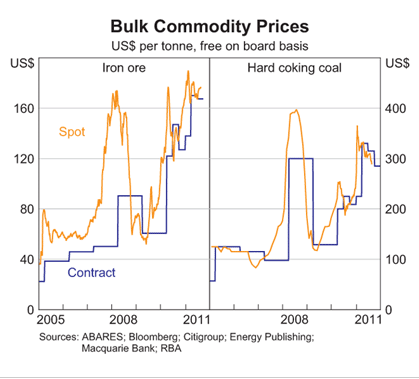
This price growth has helped send the RBA’s index of commodity prices into the stratosphere:
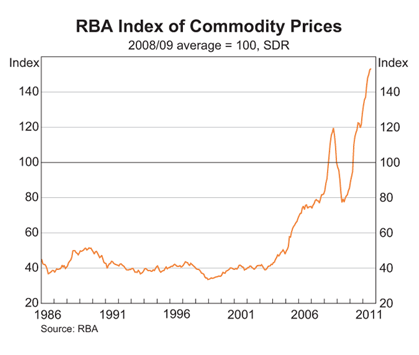
And sent Australia’s terms-of-trade to near 60-year highs:
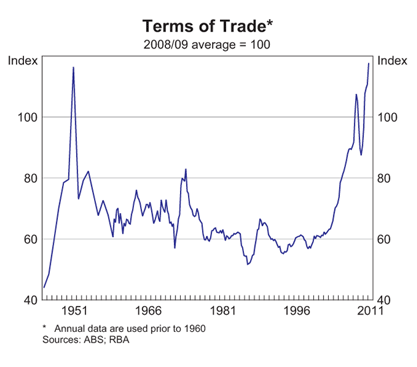
But with the global economy slowing dramtically, there are question marks over whether China has the ammunition to stimulate growth a second time? Here’s Canada’s Globe and Mail (h/t Bernard Hickey):
Now, nearly three years later, as a debt-laden Europe and a jobs-starved United States teeter once again on the precipice of recession, all eyes are back on China. Can the Middle Kingdom save the world again?
The answer, according to experts on China’s economy as well as Chinese business owners and consumers, is probably not. At least, not in the same way it did last time.
China’s economy is in a very different state today than it was at the start of the global financial crisis in 2008.
The country is still dealing with the side effects of its previous stimulus package: burdensome local government debt, stubbornly high inflation and a red-hot housing market that many say is set to blow up.
“I don’t think China will fill the void of growth that is left from a slowdown of the Western economies at this stage,” said Na Liu, the founder of CNC Asset Management and an adviser on China strategy to Scotia Capital.
“A new ‘shock and awe’ stimulus package from China like the one in 2008 is almost impossible at this stage”…
“China’s economy is weaker today than on the eve of the global crisis three years ago and won’t be able to shrug off the problems elsewhere or be able to completely offset them,” Mark Williams, the firm’s chief China economist said in a report this week.
Indeed, Chinese manufacturers, a crucial element of the country’s export-driven economy, today are grappling with a host of problems they didn’t face just a few years ago. Spiking labour and production costs, along with fast-rising competition, are grinding China’s manufacturing engine…
A factory owner named Mr Chen offers some interesting anecdotes about China’s manufacturing industry:
Many of the factories here that helped the world out of recession are now gone. The low-skill garment factories were the first to go, and now other owners are either shuttering their operations completely or moving to the Chinese interior. As the economy in China has sagged, Mr. Chen’s customers are taking longer and longer to pay for orders, asking for 30-, 60- or even 90-day payment periods, which have hit his cash flow and made him increasingly reliant on loans. However, since the state-owned banks are refusing loans to small to medium-sized businesses like his own, Mr. Chen says, he has been forced to rely on private lenders with usurious interest rates as high as 60 per cent…
“Now you have vacancies in every industrial park … If I move inland, the property there will just increase in price, too, and then what will I do?” asks Mr. Chen, standing in a crisp white shirt and khakis, holding up his hands with thoughtful resignation. “All I can do is increase efficiency. This year, I can squeeze out 20 per cent. But next year? The salaries must rise. I’m not sure I can survive.”
And an anonymous senior economic analyst that consults for the Chinese Government further cast doubt on the Chinese Government’s ability to stimulate growth a second time around:
“China may not have the same strength we used to, [in order] to help the global economy… The analyst pointed to persistent inflation, decreasing manufacturing and exports, and weak domestic consumption as evidence of China’s inability to pitch in as the world confronts yet another global downturn. “China cannot do the same things that we did in 2008.”
Still, some economists are pointing to China’s massive long-term urbanisation process, arguing that demand for commodities will remain strong:
Indeed, China’s plan to develop infrastructure and promote more urbanization in the country’s second- and third-tier cities will sustain strong economic growth and commodity demand from Western countries like Canada for years to come, according to analysts Andrew Keen, Thorsten Zimmermann and Lourina Pretorius at HSBC.
“In terms of long-term structural trends, demand is now driven by an urbanization process that is far more structural than consensus generally believes,” the analysts said in a recent report. “On our analysis, China is only 20 to 25 per cent along the path towards being a mature materials market and it may take at least six to nine years before demand intensity peaks.”
Resource company executives are making the same bet.
There may also be greater confidence amongst Chinese policy-makers following the success of their 2008 stimulus to innovate and produce a second round of fiscally-driven growth. Let’s hope that the bulls are right.

